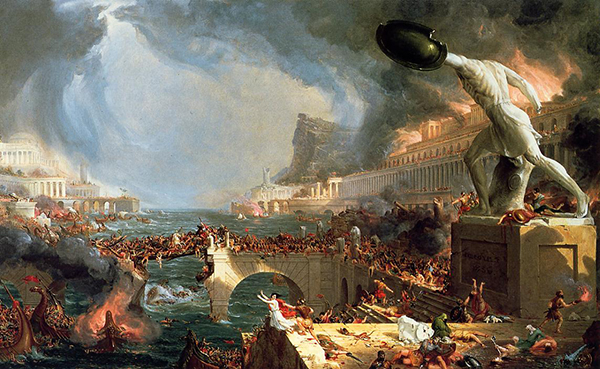"My voice sticks in my throat; and, as I dictate, sobs choke my utterance. The City which had taken the whole world was itself taken."
Jerome, Letter CXXVII (To Principia)
Just before his death in AD 395, Theodosius I divided the empire into East and West, to be ruled by his two sons: Arcadius and his younger brother Honorius, who then was only ten years old. In his stead, the West was governed by Flavius Stilicho, his guardian and commander of the army. The two halves of the empire were in contention, however, a situation exploited by Alaric, whose Visigoths had been used as allies but now, with the death of Theodosius, renounced their allegiance and rose in revolt. Alaric was able to negotiate the command of the army in Illyricum, but later there was resistance to this concession and he was obliged to leave. Alaric then invaded Italy itself and in AD 402 besieged Honorius in Milan (to where the capital of the western Roman empire had been removed more than a century before). Twice defeated by Stilicho but spared each time, Alaric were forced to retreat and persuaded instead to join in a campaign to wrest Illyricum away from the East. But the scheme was abandoned when the usurper Constantine III revolted in Britain in AD 407 and Arcadius unexpectedly died the next year.
Alaric demanded compensation, which Honorius, who now was in the new capital at Ravenna, refused to pay. Stilicho had been executed, and in AD 410 Alaric marched on Rome itself, the first time in almost eight hundred years that the "Eternal City" (in Tibullus' phrase, Elegies, II.5) had been attacked. Zosimus, who provides the only account of these events, records what happened.
"When Alaric heard that the people were trained and ready to fight, he said that thicker grass was easier to mow than thinner and laughed broadly at the ambassadors, but when they turned to discuss peace he used expressions excessive even for an arrogant barbarian: he declared that he would not give up the siege unless he got all the gold and silver in the city, as well as all movable property and the barbarian slaves. When one of the ambassadors asked what he would leave for the citizens if he took these, he replied: 'Their lives'" (The New History, V.40).
The siege of Rome was lifted only after five thousand pounds of gold, thirty thousand pounds of silver, four thousand silken tunics, three thousand scarlet-dyed hides, and three thousand pounds of pepper had been paid. Statues were stripped of their decorations and, when that was not enough, those of gold and silver melted down. When further negotiations regarding a homeland for the Goths broke down, Rome again was besieged and, this time, sacked, the fathers of the church seeking to explain such a catastrophe. The date was August 24, AD 410.
Alaric died that same year. Two years later, his kinsman Athaulf led the Visigoths into southwestern Gaul, where, in AD 418, Honorius was obliged to recognize their kingdom at Toulouse. The Vandals and other Germanic tribes who had crossed over the frozen Rhine on the last day of AD 406 were themselves in Spain under their leader, Genseric. Honorius permitted them to stay as well, although there was little he could have done otherwise. In AD 423 Honorius died and eventually was succeeded by Valentinian III, who was still a child at the time. The Vandals crossed into North Africa, defeated the Romans there, and, in AD 439, conquered Carthage, which Genseric made his capital. In AD 451, Attila and the Huns, who already had become so powerful that they were paid an annual tribute by Rome, invaded Gaul, in alliance with the Vandals. They were defeated at the Battle of Châlons by the Visigoths under the command of Flavius Aetius, military commander of the West. In AD 455, the death of Valentinian III served as a pretext for the Vandals to enter an undefended Rome, which they plundered for two weeks, carrying away the treasures of the Temple of Peace and the gilded bronze tiles from the Temple of Jupiter.
Now there are only ruins.
The picture is The Course of Empire: Destruction (1836) by Thomas Cole. The fourth in a series of five depicting the rise and fall of an ancient city, the entire cycle is in the New York Historical Society. The colossal statue in the foreground is modeled after the Borghese Gladiator (Louvre).
References: Zosimus: New History (1982) translated by Ronald T. Ridley; The Gothic History of Jordanes (1915) translated by Charles Christopher Mierow.
See also Borghese Gladiator.
